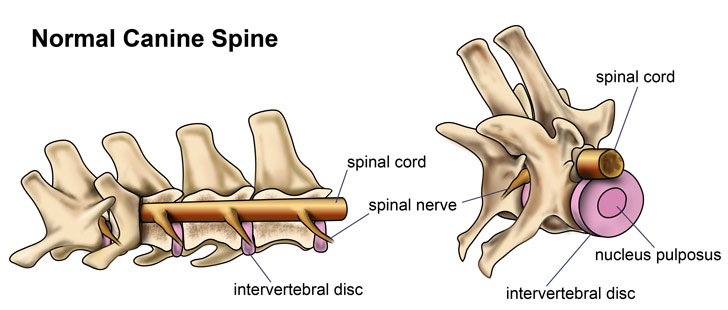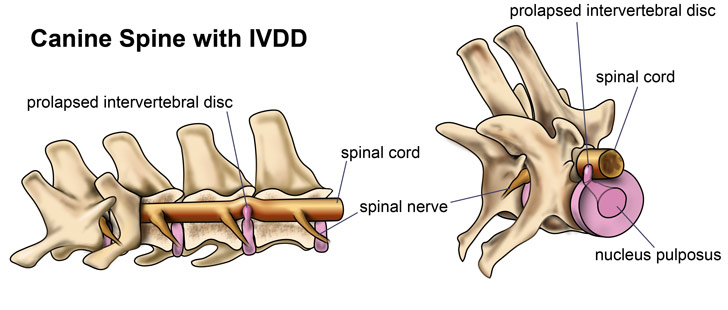IVDD: Intervertebral Disc Disease in Dogs

IVDD stands for intervertebral disc disease. It is also known as herniated disc(s) or ruptured disc(s). A dog's backbone is made up of individual bones, or vertebrae, that form a tube, within which the spinal cord is protected. Discs are the joints that connect the vertebrae to one another. They are soft in the center and have a tougher outer layer. The spine helps bear the weight of the animal and also needs to move in many different ways. The job of the discs is to work as shock absorbers for the vertebrae.

In IVDD, the material on the inside of the disc, the nucleus pulposus, degenerates over time. The disc material may escape upwards from the more fibrous outer case, the annulus fibrosis, toward the spinal cord. This material can then push either on the nerve roots that exit the spinal column and connect to the rest of the body or on the spinal cord itself. This causes pain, nerve damage, and paralysis to the area that is enervated by the affected part of the spine.

IVDD can occur anywhere along the vertebral column, from the neck to the lower back.
Presentation and Signs of IVDD in Dogs
There are many conditions that can present similarly to IVDD, but the following are all signs that should not be ignored:
- Moving stiffly
- Reluctance to move the neck up and down or from side to side
- Crying when touched or when someone gets close
- Arching the back when walking
- Defecating in the house or while lying down
- Dragging a leg while walking
- Walking on the top of a foot instead of the bottom
- Anxiousness about jumping up on furniture when this is usually done readily
- Reluctance to sit or lie down
- Trembling
- Clumsiness or wobbliness
- Weakness
- Abnormal reflexes in affected limbs
If your dog is down and unable to rise, it is an emergency and you should see a veterinarian immediately.
Breeds, Gender, and Age Most Commonly Affected by IVDD in Dogs
There are two types of IVDD in dogs, and they generally affect different breeds:
-
Hansen's Type 1 Disc Disease is a herniation of the inner gel of the disc that happens suddenly, usually due to a sudden movement or trauma. Type 1 disc disease is most common in chondrodystrophic dog breeds. Chondrodystrophy is a disorder of the cartilage formation that results in dwarfism. It is bred into certain short-legged dogs. These dogs have a genetic propensity for their nucleus pulposus to become calcified, so prior to the herniation, the disc material has degenerated and mineralized. IVDD in these dogs is usually diagnosed around middle age, and there is no sex predilection. Chondrodystrophic dog breeds include:
- Dachshunds
- Beagles
- Shih tzus
- Pekinese
- Basset Hounds
- Corgis
- Poodles
-
Hansen's Type 2 Disc Disease is a degenerative process where the nucleus pulposus protrudes from the outer fibrous portion of the disc more gradually, due to the slow degeneration of both tissues over time. Type 2 disc disease is most often diagnosed in older, large breed dogs (there is no sex predilection). It is also seen more in overweight dogs. The breeds most commonly affected are:
- German shepherds
- Dobermans
- Labradors
Diagnosis of IVDD in Dogs
- A general veterinary examination is the first step in the diagnosis of IVDD. Your veterinarian will feel the area around the spine to see if your dog shows a pain response.
-
If, after a general exam, your dog's doctor suspects IVDD, the next step is a neurological examination. The veterinarian will check your dog's reflexes to determine if any of them are slow or absent. This can help narrow your dog's problem down to a specific area of the spine. Among the things that your veterinarian will check are:
- Conscious proprioception: Your veterinarian will check to see if, when your dog's feet are placed top-down, she can flip them top-up again. If she can't, it indicates a disturbance in the nerve system that allows her to feel that her foot is in the wrong position and then right it.
- Voluntary control of urination and defecation: If your dog is unable to hold her urine or feces, this indicates a disturbance of the spinal cord.
- Superficial pain: The nerves that allow your dog to feel pain on the outer surface of her feet and legs and withdraw from it can be affected by IVDD.
- Deep pain: Your veterinarian will give your dog a little pinch in the webbing between her toes and evaluate whether she seems to feel it and if she can pull her paw away from it. The absence of this reflex indicates the presence of the most serious of nerve deficits.
- X-rays are usually recommended if the neurological exam points toward IVDD. Discs cannot be seen on plain x-rays. However, if the disc material is calcified or the space between vertebrae where the disc lies is narrowed, it indicates IVDD in that area. X-rays can also help visualize problems other than IVDD that may be causing the dog's signs, such as tumors or fractured vertebrae.
- A spinal tap may occasionally be done to ensure that the problem is not caused by an infection.
- A myelogram can be performed to verify that there is herniated disc material or a compression of the spinal cord and exactly where it is. During this procedure, general anesthesia is used, and then dye is injected into the space around the spinal cord, making it more visible on x-rays.
- A CT scan or MRI can also be done to visualize the specific problem, and these tests offer the most information.
Treatment of IVDD in Dogs
-
Conservative care can be used for IVDD if the dog is still able to walk and has appropriate pain reflexes. In this case, anti-inflammatory and pain medications and strict rest may help to resolve the IVDD. Strict rest involves confining the dog to a cage or small area where she can't get up or move around. The owner must be diligent with nursing care in this case, turning the dog over from one side to the other every hour or so, bringing food and water to the dog, and carrying her out and supporting her for urination and defecation. Strict rest is usually required for about three weeks. If the dog's signs have improved at that time, three to four more weeks can be taken to gradually increase the dog's activity level back to near normal. However, any activity that involves jumping should be removed from the dog's life for good because the risk is just too high of another disc herniation.
-
Medications: There are several families of medications that may be used to aid in the conservative care of a dog suffering from IVDD. These medications are secondary to strict rest, which is the mainstay of treatment. Never give your dog any medications without speaking to your veterinarian first. Some human medications are dangerous to dogs, and giving them may also limit the medications that your veterinarian can use afterwards, due to dangerous medication interactions.
- Steroids: Steroids such as prednisone are strong anti-inflammatory medications, and some veterinarians use them for the conservative care of IVDD. This is not agreed-upon in the profession, and you will find varying opinions on their use.
- Pain Medications: Medications that block pain are important during the conservative care of IVDD as well as before and after surgical cases. However, it is important to ensure that you don't allow the dog to move around too much even if she seems to act better on the medications.
- NSAIDs: Non-steroidal anti-inflammatory medications such as Rimadyl and Deramaxx may be used to decrease inflammation during the conservative treatment of IVDD.
- Muscle Relaxants: It is common that the muscles in the area affected by the IVDD go into spasm, and this results in additional pain for the dog. Muscle relaxants can help with this.
-
- Surgery is almost always necessary for dogs that are not able to walk anymore or do not have appropriate pain reflex responses. These things indicate that the connection between the brain and the nerves to the affected limb are no longer working, and surgery is necessary to relieve the pressure on the affected nerve.
- Physical therapy is helpful during conservative treatment and after surgical treatment. It must be done with care to ensure that your dog does not suffer further injury. There are veterinary physical therapists in many areas, including facilities that can do underwater therapy, which has very good results. Where they are not available, your veterinarian can teach you some specific physical therapy exercises and tell you how often to perform them at each stage of recovery.
Time is of the essence in the treatment of IVDD in dogs. Dogs that have been down for over 48 hours have a much smaller chance of recovering, even with surgical intervention.
Prevention of IVDD in Dogs
- Keeping your dog at a healthy weight will decrease the strain on her spine and the chances of IVDD, but disc degeneration appears to have genetic components in many cases.
- Using a harness instead of a collar for leash-walks can help prevent spinal injuries, especially to the neck. Avoid retractable leashes; dogs don't know for sure when they will hit the end, and can be jerked back and injured.
- Prevent your dog from jumping, especially jumping and twisting. When playing fetch, throw the toys low enough that your dog does not need to jump and twist to catch them. If your dog is allowed on furniture or beds, provide stairs or ramps so she doesn't have to jump up or down.
Prognosis for IVDD in Dogs
The prognosis for IVDD in dogs varies depending on the severity of the signs and how quickly treatment is initiated.
- Dogs that can still walk and retain their pain reflexes have a good chance of recovering with conservative treatment. However, they also have a much higher chance of the problem recurring than if they are treated surgically.
- Dogs that can't walk or feel pain in their feet are a surgical emergency. Even with surgery, these dogs have a lower chance of recovering than dogs that don't lose deep pain reflexes and, if they have been down for more than 48 hours, they have an extremely low chance of recovering.
Alternative therapies for IVDD in Dogs
- Acupuncture has been used as part of the physical therapy for dogs during conservative care or after surgical treatment for IVDD. Many people feel that it helps speed healing.
- Chiropractic care is recommended by some, but it is extremely controversial and is believed by most veterinarians to be dangerous in dogs with IVDD, and it may result in greater injury.
You May Also Like These Articles:
Retractable Dog Leashes: Know the Risks
Causes of Lameness in Dogs: An Overview
Panosteitis in Dogs: Growing Pains
Hands-On Guide to Checking if Your Dog Is at a Good Weight
Disclaimer: This website is not intended to replace professional consultation, diagnosis, or treatment by a licensed veterinarian. If you require any veterinary related advice, contact your veterinarian promptly. Information at DogHealth.com is exclusively of a general reference nature. Do not disregard veterinary advice or delay treatment as a result of accessing information at this site. Just Answer is an external service not affiliated with DogHealth.com.

